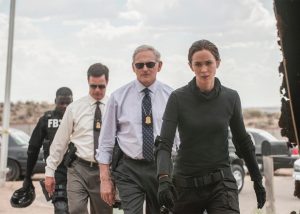After being sent to Juarez, Mexico on a mission to stop the flow of illegal drugs into America, FBI agent Kate Macer (Emily Blunt) is forced to stifle her emotions and beliefs to survive in Denis Villeneuve’s newest film, “Sicario,” which was released Sept. 18.
“Sicario” translates to “hitman” in English, representing the idea of constant violence throughout the film, but the full reasoning behind the title remains a mystery until the very end. This violence, while hard to watch, paints a real picture of the current state of Mexican border towns.

As the death toll rises in Arizona due to Mexican drug cartels, Kate is sent to Juarez, Mexico, in the hopes of capturing the leader of the cartel and bringing him to the U.S, thus stopping the flow of contraband into America.
Violent and jarring, “Sicario” doesn’t hold back in displaying the graphic extent of the brutality perpetrated by the cartels in Juarez. Featuring dead bodies concealed in buildings, sudden explosions, and gunshots sprayed in public spaces, “Sicario” creates the feeling that violence is ever-looming in Juarez.
Kate works in a inter-agency task force under Matt Graver (Josh Brolin) and a mysterious man named Alejandro (Benicio del Toro). While originally Kate believed that she was going to be working in El Paso, Texas, the group was sent to Mexico to fight the drug cartel in its own backyard.
“Sicario” is an important film in today’s America, because it forces you to watch what really happens near our border. While it is a work of fiction, it is based on events from the past and some that still occur today.
In Juarez, the cartel is law. The police are paid off by cartel leaders and dead bodies are hung in public spaces as warnings to the general population of the power of the cartel and their vengeance towards those who cross them.
Kate’s main leader, Matt Graver, leads the task force with a certain nonchalance, even in the gravest of situations. Actions, like whistling casually as a man is waterboarded in front of him, and joking with group members while planning the extraction of a cartel leader, create the feeling of a man who has become desensitized to violence and could act dangerously without a second thought.
The other leader of the task-force is a man only identified as Alejandro. While not much is known about Alejandro’s background, he is immediately seen as a powerful man capable of anything. Benicio del Toro is able to portray Alejandro in a grim and stern way that makes the viewer feel as if something in his past molded his character.

While the plot of the film seems to be focused on a brief event, relatively inconsequential to the large scale of cartel violence, its focus allows the viewer to get an in-depth look at an example of something that occurs often.
Many today are aware of the problems near our southern border, but few fully grasp the extent of those affected by these issues. The amount of violence and government corruption is immense in Mexico and these problems shape not only that country, but also our own.
While the issues of cartel violence in this film aren’t easy to watch or enjoyable to think about, they are real issues and “Sicario” is adept at making the audience consider the bloodshed caused by the drug trafficking in Mexico.
This issue is a focus of many politicians today in America, and while, “Sicario” may shine a negative light on certain regions of Mexico, it forces the average American to really consider the extent of the violence related to illegal drugs in America.
Denis Villeneuve’s newest film, while somewhat slow in the middle, is an action packed thriller that forces American viewers to consider the current state of their borders long after exiting the theater.






